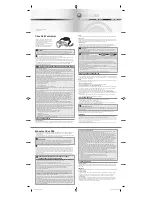
VLT
®
2800 Series
Earth fault
The IGBT module cuts out within 100
µ
s in case
of an earth fault on one of the motor terminals
U, V, W (96, 97, 98), although depending on
impedance and motor frequency.
Output connection
Motor terminals U, V, W (96, 97, 98) for the motor
can be connected/disconnected as often as required.
There is no way that the frequency converter can be
destroyed by connecting/disconnecting the motor
terminals. However, fault messages may appear.
Motor-generated overvoltage
The voltage in the intermediate circuit is increased
when the motor acts as a generator. To protect the
frequency converter the IGBT module is disconnected
when a specific voltage level is reached.
Motor-generated overvoltage can occur in
two instances:
1. The load drives the motor, i.e. the load
generates energy.
2. During deceleration (ramp-down) if the moment
of inertia is high, the load is low and the
ramp-down time too short for the energy to be
dissipated as a loss in the frequency converter,
the motor and the unit. The control unit attempts
to correct the ramp if possible.
The fault can be removed by connecting a brake
resistor, if the frequency converter has an integrated
brake module. If the frequency converter does not
have an integrated brake module an AC brake can
be used, see parameter 400
Brake function
.
See the section entitled
Brake resistors
.
Static overloading
When the frequency converter is overloaded (current
limit in parameter 221
Current limit I
LIM
is reached), the
control reduces the output frequency in an attempt
to reduce the load. If the overloading is extreme,
there might be an output current that causes the
frequency converter to trip after approx. 1.5 sec. See
parameter 409
Trip delay overcurrent, I
LIM
.
An extreme overload will cause the switching
frequency to be derated to 3000 Hz.
■
dU/dt on motor
When a transistor in the inverter is opened, the
voltage across the motor terminals will rise by a
voltage/time ratio (dU/dt) determined by:
-
the motor cable (type, cross-section, induction,
capacity, length and screened/armoured/un-
screened/unarmoured)
-
the mains voltage
Self-induction in the motor cable leads to an overswing
U
PEAK
of the output voltage each time a transistor
in the inverter is opened. After U
PEAK
the output
voltage will stabilise at a level determined by the
voltage in the intermediate circuit. U
PEAK
and dU/dt
influence the lifetime of the motor, especially motors
without phase insulation paper in the coils. If the
motor cable is short (a few metres), the overshoot
U
PEAK
is low, while the dU/dt is high. If the motor
cable is long (>20 m), U
PEAK
is increased, while dU/dt
decreases. When using small motors without phase
insulation paper, it is recommended that an LC-filter
is connected after the frequency converter.
■
Switching on the input
The waiting time between switching the mains
voltage on terminals 91, 92 and 93 must be min.
30 sec. Start up time appr. 2.3 sec.
■
Acoustic noise
The acoustic noise from the frequency converter
comes from two sources:
1. DC intermediate circuit coils.
2. Integral fan.
Below are the typical values measured at a distance
of 1 m from the unit at full load:
VLT 2803-2815 1 x 220 V: 52 dB(A).
VLT 2803-2822 3 x 220 V: 52 dB(A).
VLT 2805-2840 3 x 400 V: 52 dB(A).
VLT 2855-2875 3 x 400 V: 54 dB(A).
VLT 2880-2882 3 x 400 V: 55 dB(A).
■
Derating for ambient temperature
The ambient temperature (T
AMB,MAX
) is the maximum
temperature allowed. The average (T
AMB,AVG
)
measured over 24 hours, must be at least 5
°C lower. If the frequency converter operates
at temperatures above 45 °C, a derating of the
rated output current is necessary.
MG.28.E9.02 - VLT is a registered Danfoss trademark
132
















































